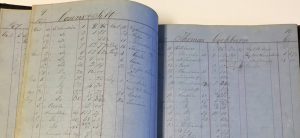“I had a little bird, its name was Enza, I opened up the window and in flew Enza ” (Children’s skipping-rope rhyme, 1918)
 In October, 1918, Kitchener became one of the many cities stricken with the Spanish Flu, named after the incorrect belief that it had originated in Spain. This was the ‘second wave’ of three that would impact people all over the world. To add insult to injury, the world was still in the midst of the First World War, which did not end until November 11th of that year.
In October, 1918, Kitchener became one of the many cities stricken with the Spanish Flu, named after the incorrect belief that it had originated in Spain. This was the ‘second wave’ of three that would impact people all over the world. To add insult to injury, the world was still in the midst of the First World War, which did not end until November 11th of that year.
During this time, in the nearby in the village of Doon, Homer Watson was mourning the loss of his beloved wife, Roxanna, and was struggling to find the inspiration to paint again. Roxanna had suffered from the heart condition Angina Pectoris for many years, having recurring attacks. She eventually succumbed to the illness on January 12, 1918. To add to Watson’s woes, a few months following the death of his wife, his eleven-year-old daughter, Mary, became ill. Whether or not Mary caught the Spanish Flu is unknown, Watson was not specific about her illness in his correspondence, but Mary was gravely ill. Homer even hired a nurse to tend to his daughter. Mary did not fully recover from this illness until 1919. In light of these events, Homer’s sister, Phoebe Watson, closed her Fancy Goods Store in Galt and moved in with Homer and Mary to help Homer cope with the loss of his wife and the illness of his daughter.
At the end of the Spanish Flu, 300 000 Ontarians had fallen ill and 8705 had died. It is estimated that worldwide, 50 million people perished from the Spanish Flu. By January, 1920, The Spanish Flu epidemic was over, there was peace once again in Europe, Mary Watson had fully recovered from her illness and Homer Watson was painting again.

















